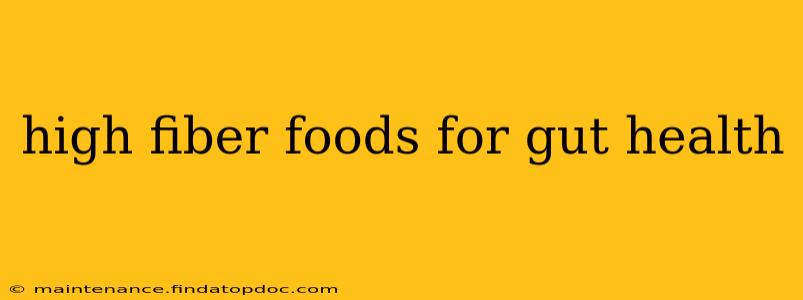Maintaining a healthy gut is crucial for overall well-being. A diverse and thriving gut microbiome contributes to better digestion, stronger immunity, and even improved mental health. One of the most effective ways to support your gut health is by incorporating plenty of fiber into your diet. Fiber, a type of carbohydrate the body can't digest, acts as food for the beneficial bacteria in your gut, promoting a balanced and healthy microbiome. This guide explores high-fiber foods that can significantly improve your gut health.
What are the benefits of high-fiber foods for gut health?
Fiber's impact on gut health is multifaceted. It feeds the good bacteria in your gut, promoting their growth and activity. This, in turn, helps regulate bowel movements, preventing constipation and promoting regularity. Moreover, fiber helps maintain a healthy gut barrier, preventing harmful substances from leaking into the bloodstream. This protective function contributes to a reduced risk of inflammation and various health problems.
What are some high-fiber foods I can eat?
Many delicious and nutritious foods are packed with fiber. Let's explore some key categories:
Fruits:
- Apples: A medium apple with the skin contains about 4 grams of fiber. Aim for varieties like Granny Smith or Fuji.
- Berries (strawberries, raspberries, blueberries, blackberries): Berries are low in calories but high in fiber and antioxidants, making them a fantastic addition to your diet. A cup of raspberries, for example, provides around 8 grams of fiber.
- Bananas: Especially when slightly green, bananas are a good source of both soluble and insoluble fiber. A medium banana provides about 3 grams of fiber.
- Avocado: While technically a fruit, avocados are rich in healthy fats and fiber. Half an avocado contains about 7 grams of fiber.
- Pears: Similar to apples, pears are a good source of fiber, particularly when consumed with the skin. A medium pear provides about 5 grams of fiber.
Vegetables:
- Broccoli: A cup of cooked broccoli offers about 5 grams of fiber.
- Brussels sprouts: These small, nutrient-packed vegetables provide about 4 grams of fiber per cup when cooked.
- Carrots: A cup of chopped carrots provides about 4 grams of fiber. Aim for raw carrots for maximum fiber retention.
- Spinach: While not as high in fiber as other vegetables, spinach still contributes to your daily fiber intake. A cup of cooked spinach provides around 4 grams of fiber.
- Sweet potatoes: A medium sweet potato provides about 3 grams of fiber.
Legumes:
- Lentils: A cup of cooked lentils boasts approximately 16 grams of fiber—a significant contribution to your daily needs.
- Beans (kidney, black, pinto, etc.): Most beans are fiber powerhouses. A cup of cooked kidney beans, for example, contains about 11 grams of fiber.
- Chickpeas: Also known as garbanzo beans, chickpeas are a versatile and fiber-rich legume. A cup of cooked chickpeas contains around 12 grams of fiber.
Grains:
- Oats: Oats are a fantastic source of soluble fiber, which is particularly beneficial for gut health. A half cup of cooked oatmeal provides around 4 grams of fiber.
- Whole wheat bread: Choose whole wheat over white bread to significantly increase your fiber intake. One slice of whole wheat bread typically provides about 2 grams of fiber.
- Brown rice: Brown rice contains more fiber than white rice. A half cup of cooked brown rice provides around 2 grams of fiber.
- Quinoa: This complete protein is also a good source of fiber. A half cup of cooked quinoa offers about 3 grams of fiber.
How much fiber should I eat per day?
The recommended daily fiber intake varies depending on age and gender. However, most health organizations suggest aiming for 25-30 grams of fiber per day. Gradually increase your fiber intake to avoid digestive discomfort.
What happens if I don't get enough fiber?
Insufficient fiber intake can lead to various digestive issues, including constipation, bloating, and irregular bowel movements. Long-term fiber deficiency can also increase the risk of certain health problems.
Are there any potential downsides to eating too much fiber?
While fiber is generally beneficial, consuming excessive amounts too quickly can cause gas, bloating, and abdominal discomfort. It's important to increase your fiber intake gradually to allow your gut to adapt. Drink plenty of water to aid digestion when increasing fiber consumption.
What are some tips for adding more fiber to my diet?
- Start slowly: Gradually increase your fiber intake to avoid digestive upset.
- Choose whole grains: Opt for whole-grain bread, pasta, and rice over refined grains.
- Add fruits and vegetables to every meal: Include a serving of fruits or vegetables with breakfast, lunch, and dinner.
- Snack on high-fiber foods: Keep high-fiber snacks like nuts, seeds, or fruits readily available.
- Read food labels: Pay attention to the fiber content listed on food labels.
- Drink plenty of water: Adequate hydration is essential for proper fiber digestion.
By incorporating these high-fiber foods into your daily diet and following these tips, you can significantly improve your gut health and overall well-being. Remember to consult with a healthcare professional or registered dietitian if you have any specific dietary concerns or health conditions.
